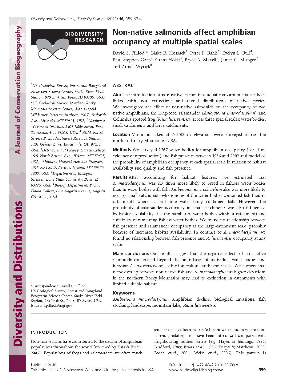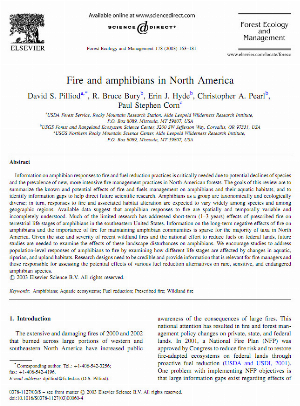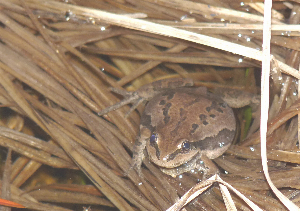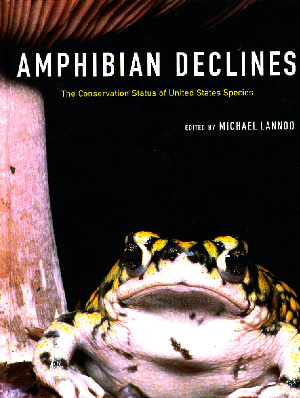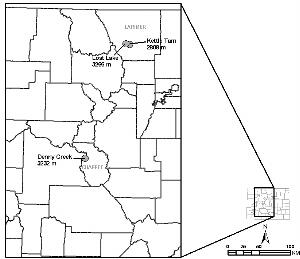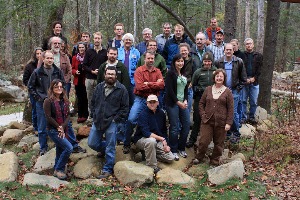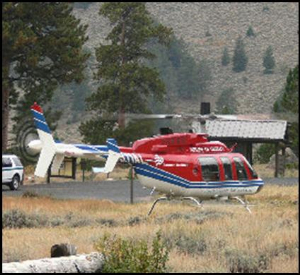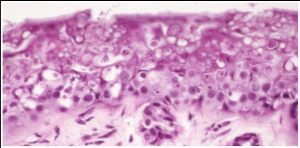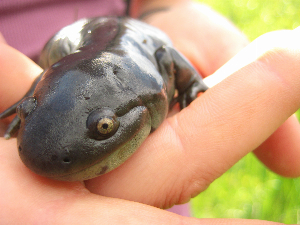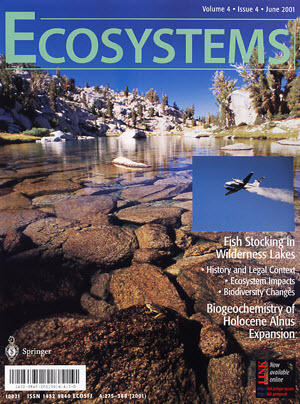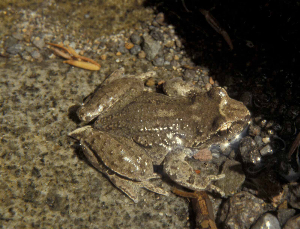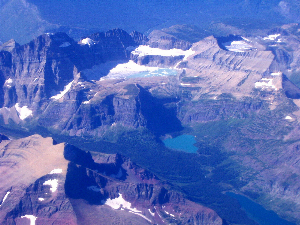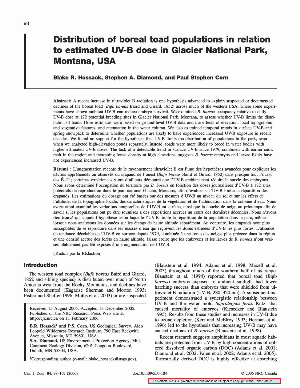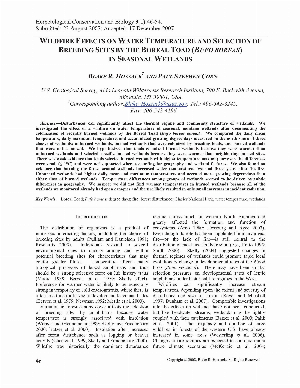Search ARMI Database
Search term(s)
Contribution Number
Search Results
70 record(s) found.
Papers & Reports Non-native salmonids affect amphibian occupancy at multiple spatial scales
Authors: David S Pilliod; Blake R Hossack; Peter F Bahls; Evelyn L Bull; P. Stephen Corn; G Hokit; B A Maxell; J C Munger; P Murphy; A Wyrick
Date: 2010 | Outlet: Diversity and Distributions 16: 959–974
Aim
The introduction of non-native species into aquatic environments has been linked with local extinctions and altered distributions of native species. We investigated the effect of non-native salmonids on the occupancy of two native amphibians, the long-toed salamander (Ambystoma macrodactylum) and Columbia spotted frog (Rana luteiventris), across three spatial scales: water bodies, small catchments and large catchments.
Location
Mountain lakes at >1500 m elevation were surveyed across the northern Rocky Mountains, USA.
Methods
We surveyed 2267 water bodies for amphibian occupancy (based on evidence of reproduction) and fish presence between 1986 and 2002 and modelled the probability of amphibian occupancy at each spatial scale in relation to habitat availability and quality and fish presence.
Results
After accounting for habitat features, we estimated that A. macrodactylum was 2.3 times more likely to breed in fishless water bodies than in water bodies with fish. Ambystoma macrodactylum also was more likely to occupy small catchments where none of the water bodies contained fish than in catchments where at least one water body contained fish. However, the probability of salamander occupancy in small catchments was also influenced by habitat availability (i.e. the number of water bodies within a catchment) and suitability of remaining fishless water bodies. We found no relationship between fish presence and salamander occupancy at the large-catchment scale, probably because of increased habitat availability. In contrast to A. macrodactylum, we found no relationship between fish presence and R. luteiventris occupancy at any scale.
Main conclusions
Our results suggest that the negative effects of non-native salmonids can extend beyond the boundaries of individual water bodies and increase A. macrodactylum extinction risk at landscape scales. We suspect that niche overlap between non-native fish and A. macrodactylum at higher elevations in the northern Rocky Mountains may lead to extinction in catchments with limited suitable habitat.
The introduction of non-native species into aquatic environments has been linked with local extinctions and altered distributions of native species. We investigated the effect of non-native salmonids on the occupancy of two native amphibians, the long-toed salamander (Ambystoma macrodactylum) and Columbia spotted frog (Rana luteiventris), across three spatial scales: water bodies, small catchments and large catchments.
Location
Mountain lakes at >1500 m elevation were surveyed across the northern Rocky Mountains, USA.
Methods
We surveyed 2267 water bodies for amphibian occupancy (based on evidence of reproduction) and fish presence between 1986 and 2002 and modelled the probability of amphibian occupancy at each spatial scale in relation to habitat availability and quality and fish presence.
Results
After accounting for habitat features, we estimated that A. macrodactylum was 2.3 times more likely to breed in fishless water bodies than in water bodies with fish. Ambystoma macrodactylum also was more likely to occupy small catchments where none of the water bodies contained fish than in catchments where at least one water body contained fish. However, the probability of salamander occupancy in small catchments was also influenced by habitat availability (i.e. the number of water bodies within a catchment) and suitability of remaining fishless water bodies. We found no relationship between fish presence and salamander occupancy at the large-catchment scale, probably because of increased habitat availability. In contrast to A. macrodactylum, we found no relationship between fish presence and R. luteiventris occupancy at any scale.
Main conclusions
Our results suggest that the negative effects of non-native salmonids can extend beyond the boundaries of individual water bodies and increase A. macrodactylum extinction risk at landscape scales. We suspect that niche overlap between non-native fish and A. macrodactylum at higher elevations in the northern Rocky Mountains may lead to extinction in catchments with limited suitable habitat.
Papers & Reports Fire and amphibians in North America
Authors: David S Pilliod; Richard B Bury; E J Hyde; Christopher A Pearl; P. Stephen Corn
Date: 2003 | Outlet: Forest Ecology and Management 178: 163–181
Information on amphibian responses to fire and fuel reduction practices is critically needed due to potential declines of species and the prevalence of new, more intensive fire management practices in North American forests. The goals of this review are to summarize the known and potential effects of fire and fuels management on amphibians and their aquatic habitats, and to identify information gaps to help direct future scientific research. Amphibians as a group are taxonomically and ecologically diverse; in turn, responses to fire and associated habitat alteration are expected to vary widely among species and among geographic regions. Available data suggest that amphibian responses to fire are spatially and temporally variable and incompletely understood. Much of the limited research has addressed short-term (1–3 years) effects of prescribed fire on terrestrial life stages of amphibians in the southeastern United States. Information on the long-term negative effects of fire on amphibians and the importance of fire for maintaining amphibian communities is sparse for the majority of taxa in North America. Given the size and severity of recent wildland fires and the national effort to reduce fuels on federal lands, future studies are needed to examine the effects of these landscape disturbances on amphibians. We encourage studies to address population-level responses of amphibians to fire by examining how different life stages are affected by changes in aquatic, riparian, and upland habitats. Research designs need to be credible and provide information that is relevant for fire managers and those responsible for assessing the potential effects of various fuel reduction alternatives on rare, sensitive, and endangered amphibian species.
Papers & Reports Amphibian decline in Yellowstone National Park
Authors: Debra A Patla; Charles R Peterson; P. Stephen Corn
Date: 2009 | Outlet: Proceedings of the National Academy of Sciences, USA 106(9): E22
As researchers engaged in long-term amphibian monitoring in Yellowstone National Park (YNP), we read the paper by McMenamin et al. with interest. This study documents a decline in the extent of seasonal wetlands in the Lamar Valley of YNP during an extended drought, but their conclusion, widely reported in the media, of “severe declines in 4 once-common amphibian species”, is unsupported. Their analysis incorrectly defines populations, ignores significant inter-annual variation in amphibian occurrence, and is applicable to only a tiny fraction of YNP.
Papers & Reports Bufo baxteri Porter, 1968, Wyoming toad
Authors: R A Odum; P. Stephen Corn
Date: 2005 | Outlet: Lannoo M, editor. Amphibian declines: the conservation status of United States species. Berkeley: University of California Press 390–392
Species account of the Endangered Wyoming Toad.
Papers & Reports Estimation of the probability of male toads to return to the breeding site
Authors: Erin Muths; R D Scherer; P. Stephen Corn; Brad A Lambert
Date: 2006 | Outlet: Ecology 87: 1048–1056
Male boreal toads are thought to return to the breeding site year after year and, if absent in a particular year, be more likely to be present the following year. Using Pollock’s robust design we estimated temporary emigration (the probability a male toad is absent from a breeding site in a given year) at locations in Colorado: Rocky Mountain National Park (n=2) and Chaffee County (n=1). We present data that suggest that male toads do not return to the breeding site every year. Estimates of both temporary emigration parameters ( ’ = probability that a male toad is absent from the breeding site at time i if absent at time i - 1; ” = probability that a male toad is absent at time i if present at time i - 1) varied by site and time (for example, at Lost Lake, the probability of temporary emigration ranged from 10 - 29%). Although we suspected that the probability of temporary emigration would be state dependent (Markovian temporary emigration, e.g. whether a male toad is at the breeding site at time i is affected by whether it was at the breeding site at time i - 1), the data showed greater support for models of random temporary emigration or no emigration. However, some models of Markovian emigration were supported. We also hypothesized relationships between temporary emigration and a number of environmental variables. While some competitive models included environmental covariates, model selection uncertainty precluded fully defining the role of these covariates in temporary emigration.
Papers & Reports The U.S. Department of Interior’s Amphibian Research and Monitoring Initiative: a successful start to a national program
Authors: Erin Muths; R E Jung; Larissa L Bailey; Michael J Adams; P. Stephen Corn; Kenneth C Dodd; Gary M Fellers; Walt J Sadinski; Cecil R Schwalbe; Susan C Walls; Robert N Fisher; A L Gallant; William A Battaglin; David E Green
Date: 2005 | Outlet: Applied Herpetology 2: 355–371
Most research to assess amphibian declines has focused on local-scale projects on one or a few species. The Amphibian Research and Monitoring Initiative (ARMI) is a national program in the United States mandated by congressional directive and implemented by the U.S. Department of the Interior (specifically the U.S. Geological Survey, USGS). Program goals are to monitor changes in populations of amphibians across U.S. Department of the Interior lands and to address research questions related to amphibian declines using a hierarchical framework of base-, mid- and apex-level monitoring sites. ARMI is currently monitoring 83 amphibian species (29% of species in the U.S.) at mid- and apex-level areas. We chart the progress of this 5-year-old program and provide an example of mid-level monitoring from 1 of the 7 ARMI regions.
Papers & Reports Experimental repatriation of boreal toad (Bufo boreas) eggs, metamorphs, and adults in Rocky Mountain National Park
Authors: Erin Muths; T L Johnson; P. Stephen Corn
Date: 2001 | Outlet: Southwestern Naturalist 46: 106–113
The boreal toad (Bufo boreas) is an endangered species in Colorado and is considered a candidate species for federal listing by the United States Fish and Wildlife Service. Boreal toads are absent from many areas of suitable habitat in the Southern Rocky Mountains of Colorado presumably due to a combination of causes. We moved boreal toads from existing populations and from captive rearing facilities to habitat which was historically, but is not currently, occupied by toads to experimentally examine methods of repatriation for this species.
Papers & Reports Use of oxytetracycline in batch-marking post-metamorphic boreal toads
Authors: Erin Muths; P. Stephen Corn; T R Stanley
Date: 2000 | Outlet: Herpetological Review 31: 28–32
Tetracycline has been used to batch-mark hatchery-reared fish with some success. It is incorporated into bone and fluoresces when prepared sections are viewed under a microscope with UV light. We investigated its utility for marking large numbers of metamorphic boreal toads, Bufo boreas. We concluded that this is not a useful technique. Marks were ambiguous - exposure to tetracycline was often indistinguishable from autofluorescence in unexposed animals.
Papers & Reports Evidence for disease-related amphibian decline in Colorado
Authors: Erin Muths; P. Stephen Corn; A P Pessier; David E Green
Date: 2003 | Outlet: Biological Conservation 110: 357–365
The recent discovery of a pathogenic fungus (Batrachochytrium dendrobatidis) associated with declines of frogs in the American and Australian tropics, suggests that at least the proximate cause, may be known for many previously unexplained amphibian declines. We have monitored boreal toads in Colorado since 1991 at four sites using capture – recapture of adults and counts of egg masses to examine the dynamics of this metapopulation. Numbers of male toads declined in 1996 and 1999 with annual survival rate averaging 78 % from 1991–1994, 45 % in 1995 and 3 % between 1998 and 1999. Numbers of egg masses also declined. An etiological diagnosis of chytridiomycosis consistent with infections by the genus Batrachochytrium was made in 6 wild adult toads. Characteristic histomorphological features (i.e. intracellular location, shape of thalli, presence of discharge tubes and rhizoids) of chytrid organisms, and host tissue response (acanthosis and hyperkeratosis) were observed in individual toads. These characteristics were indistinguishable from previously reported mortality events associated with chytrid fungus. We also observed epizootiological features consistent with mortality events associated with chytrid fungus: an increase in the ratio of female:male toads captured, an apparent spread of mortalities within the metapopulation and mortalities restricted to post metamorphic animals. Eleven years of population data suggest that this metapopulation of toads is in danger of extinction, pathological and epizootiological evidence indicates that B. dendrobatidis has played a proximate role in this process.
Papers & Reports Boreal toads
Authors: Erin Muths; P. Stephen Corn
Date: 2000 | Outlet: Reading RP, Miller BJ, editors. Endangered animals: a reference guide to conflicting issues. Westport, CT: Greenwood Press 60–65
From Library Journal Reading and Miller (Prairie Night: Black-Footed Ferrets and the Recovery of Endangered Species) are conservation biologists who present 49 case studies of endangered animals. The case studies are signed and represent the work of 70 individuals from 16 countries. They give the common name, scientific name, order, family, status, a list of threats, habitats, distribution, natural history, conflicting issues, and prognosis for each animal. They further provide a list of selected conservation organizations. An essay on the Yellowstone Grizzly Bear case by Tim W. Clark is also included, as is an essay by the editors. Gale's Encyclopedia of Endangered Species (LJ 1/95), which covers over 700 animals and plants, is obviously wider in scope, but it is less scholarly and extensive for the animals covered here. The Official World Wildlife Fund Guide to Endangered Species of North America (LJ 6/15/92. o.p.) is a solid tool but limited by region. The Grolier World Encyclopedia of Endangered Species (Grolier, 1992. o.p.) offers color pictures, which this lacks. Although the number of animals is limited, this guide is recommended for academic libraries requiring more detailed, scholarly information on specific animals and for the bibliography provided for each animal. Paul Haschak, Southeastern Louisiana Univ. Lib., Hammond Copyright 2001 Reed Business Information, Inc. --This text refers to the Hardcover edition.
Papers & Reports Hatching success in two species of amphibians in northern Colorado in relation to water chemistry and climate
Authors: Erin Muths; D H Campbell; P. Stephen Corn
Date: 2003 | Outlet: Amphibia-Reptilia 24: 27–36
The snowpack in the vicinity of the Mount Zirkel Wilderness Area is among the most acidic in the western United States. We analyzed water chemistry and examined hatching success in tiger salamanders and chorus frogs at ponds there and at nearby Rabbit Ears Pass (Dumont) to determine whether acid deposition affects amphibians or their breeding habitats at these potentially sensitive locations. We found a wide range of acid neutralizing capacity among ponds within sites; the minimum pH recorded during the experiment was 5.4 at one of 12 ponds with all others at pH  5.7. At Dumont, hatching success for chorus frogs was greater in ponds with low acid neutralizing capacity; however, lowest pHs were  5.8. At current levels of acid deposition, weather and pond characteristics are likely more important than acidity in influencing hatching success in amphibian larvae at these sites.
Papers & Reports Distribution and pathogenicity of Batrachochytrium dendrobatidis in boreal toads from the Grand Teton area of western Wyoming
Authors: P J Murphy; S St-Hilaire; Sarah Bruer; P. Stephen Corn; Charles R Peterson
Date: 2009 | Outlet: EcoHealth 6: 109–120
The pathogen Batrachochytrium dendrobatidis (Bd), which causes the skin disease chytridiomycosis, has been linked to amphibian population declines and extinctions worldwide. Bd has been implicated in recent declines of boreal toads, Bufo boreas boreas, in Colorado but populations of boreal toads in western Wyoming have high prevalence of Bd without suffering catastrophic mortality. In a field and laboratory study, we investigated the prevalence of Bd in boreal toads from the Grand Teton ecosystem in Wyoming and tested the pathogenicity of Bd to these toads in several environments.
Papers & Reports The introduction of nonnative fish into wilderness lakes: good intentions, conflicting mandates, and unintended consequences
Authors: Roland A Knapp; P. Stephen Corn; D E Schindler
Date: 2001 | Outlet: Ecosystems 4: 275–278
Collectively, these papers indicate that the effects of widespread trout introductions into wilderness landscapes are not limited simply to direct effects on prey taxa, but instead can be transmitted throughout lake food webs and even beyond the shorelines of fish-containing lakes to fishless lakes. In addition, following fish removal, full recovery of ecosystem structure and function may not occur. These results pose a difficult challenge for fisheries and wilderness managers interested in better balancing the conflicting goals of maintaining nonnative fisheries in wilderness areas while also minimizing the effects of these fisheries on natural processes. If managers are to truly balance these often opposing goals, it is imperative that current fisheries management practices be evaluated in the context of their effects on ecosystem and landscape processes. It is our hope that this special feature will provide the impetus for such an evaluation and for the adoption of new management strategies to reduce the ecological impacts of nonnative fisheries in protected areas.
Papers & Reports Taxonomic variation in oviposition by tailed frogs (Ascaphus spp.)
Authors: N E Karraker; David S Pilliod; Michael J Adams; Evelyn L Bull; P. Stephen Corn; L V Diller; L A Dupuis; Marc P Hayes; Blake R Hossack; G R Hodgson; E J Hyde; K Lohman; B R Norman; Lisa M Ollivier; Christopher A Pearl
Date: 2006 | Outlet: Northwestern Naturalist 87: 87-97
Tailed frogs (Ascaphus spp.) oviposit in cryptic locations in streams of the Pacific Northwest and Rocky Mountains. This aspect of their life history has restricted our understanding of their reproductive ecology. The recent split of A. montanus in the Rocky Mountains from A. truei was based on molecular differentiation, and comparisons of their ecology are limited. Our objectives were to provide a range-wide summary of information on Ascaphus oviposition,compare some aspects of the reproductive ecology of the 2 species, and examine geographic variation in their reproductive traits. Reproductive ecology of the 2 species differed. Ascaphus truei had smaller clutches, oviposited later in the summer, and had a longer duration of oviposition than A. montanus. A greater number of communal oviposition sites were attributed to A. montanus. These ecological differences support the recent taxonomic revision of Ascaphus and suggest that different management strategies may be necessary for each species where conservation is a priority.
Papers & Reports Lack of significant changes in the herpetofauna of Theodore Roosevelt National Park, North Dakota, since the 1920s
Authors: Blake R Hossack; David S Pilliod; P. Stephen Corn
Date: 2005 | Outlet: American Midland Naturalist 154: 423–432
We surveyed 88 upland wetlands and 12 1-km river sections for amphibians in Theodore Roosevelt National Park, North Dakota, during 2001–2002 to gather baseline data for future monitoring efforts and to evaluate changes in the distribution of species. We compared our results to collections of herpetofauna made during 1920–1922, 1954 and 1978–1979. The boreal chorus frog (Pseudacris maculata) was the most common amphibian in upland wetlands, followed by the tiger salamander (Ambystoma tigrinum), Woodhouse’s toad (Bufo woodhousii), northern leopard frog (Rana pipiens), plains spadefoot (Spea bombifrons) and the Great Plains toad (B. cognatus). Bufo woodhousii was the only species that bred in the river. Our records for reptiles are less complete than for amphibians but no losses from the community are evident. The herpetofauna in Theodore Roosevelt National Park seems unchanged during at least the last half-century and likely since 1920–1922.
Papers & Reports Distribution limits of Batrachochytrium dendrobatidis: a case study in the Rocky Mountains, USA
Authors: Blake R Hossack; Erin Muths; Chauncey W Anderson; Julie A Kirshtein; P. Stephen Corn
Date: 2009 | Outlet: Journal of Wildlife Diseases 45: 1198–1202
Knowledge of the environmental constraints on a pathogen is critical to predicting its dynamics and effects on populations. Batrachochytrium dendrobatidis (Bd), an aquatic fungus that has been linked with widespread amphibian declines, is ubiquitous in the Rocky Mountains. As part of assessing the distribution limits of Bd in our study area, we sampled the water column and sediments for Bd zoospores in 30 high-elevation water bodies that lacked amphibians. All water bodies were in areas where Bd has been documented from neighboring, lower-elevation areas. We targeted areas lacking amphibians because existence of Bd independent of amphibians would have both ecologic and management implications. We did not detect Bd, which supports the hypothesis that it does not live independently of amphibians. However, assuming a detection sensitivity of 59.5% (based on sampling of water where amphibians tested positive for Bd), we only had 95%confidence of detecting Bd if it was in $16% of our sites. Further investigation into potential abiotic reservoirs is needed, but our results provide a strategic step in determining the distributional and environmental limitations of Bd in our study region.
Papers & Reports Thermal characteristics of amphibian microhabitats in a fire-disturbed landscape
Authors: Blake R Hossack; Lisa A Eby; P. Stephen Corn
Date: 2009 | Outlet: Forest Ecology and Management 258: 1414–1421
Disturbance has long been a central issue in amphibian conservation, often regarding negative effects of logging or other forest management activities, but some amphibians seem to prefer disturbed habitats. After documenting increased use of recently burned forests by boreal toads (Bufo boreas), we hypothesized that burned habitats provided improved thermal opportunities in terrestrial habitats. We tested this hypothesis by conducting a radio telemetry study of habitat use (reported previously) and by using physical models that simulated the temperature of adult toads. We deployed 108 physical models in and adjacent to a 1-year old burn using a fully-replicated design with three burn severities (unburned, partial, high severity) and four microhabitats (open surface, under vegetation, under log, in burrow). Model temperatures were compared to a range of preferred temperatures in published studies. We found 70% more observations within the preferred temperature range of B. boreas in forests burned with high severity than in unburned areas. Burned forest was warmer than unburned forest across all microhabitats, but the largest relative difference was in burrows, which averaged 3 8C warmer in high-severity burn areas and remained warmer though the night. More than twice as many observations were within the preferred temperature range in high-severity burrows than in unburned burrows. Areas burned with high severity were still warmer than unburned forest 3 years after the fire. Habitat use of toads during the concurrent radio telemetry studymatched that predicted by the physical models. These results suggest there are fitness-linked benefits to toads using burned habitats, such as increased growth, fertility, and possibly disease resistance. However, increased soil temperatures that result from wildfire may be detrimental to other amphibian species that prefer cooler temperatures and stable environments. More broadly, our data illustrate the use of physical models to measure and interpret changes that amphibians may experience from disturbance, and highlight the need for research linking vital rates such as growth and survival to disturbance.
Papers & Reports Distribution of the boreal toad populations in relation to estimated UV-B dose in Glacier National Park, Montana, USA
Authors: Blake R Hossack; S Diamond; P. Stephen Corn
Date: 2006 | Outlet: Canadian Journal of Zoology 84: 98–107
A recent increase in ultraviolet B radiation is one hypothesis advanced to explain suspected or documented declines of the boreal toad (Bufo boreas Baird and Girard, 1852) across much of the western USA, where some experiments have shown ambient UV-B can reduce embryo survival. We examined B. boreas occupancy relative to daily UV-B dose at 172 potential breeding sites in Glacier National Park, Montana, to assess whether UV-B limits the distribution of toads. Dose estimates were based on ground-level UV-B data and the effects of elevation, local topographic and vegetative features, and attenuation in the water column. We also examined temporal trends in surface UV-B and spring snowpack to determine whether populations are likely to have experienced increased UV-B exposure in recent decades. We found no support for the hypothesis that UV-B limits the distribution of populations in the park, even when we analyzed high-elevation ponds separately. Instead, toads were more likely to breed in water bodies with higher estimated UV-B doses. The lack of a detectable trend in surface UV-B since 1979, combined with earlier snow melt in the region and increasing forest density at high elevations, suggests B. boreas embryos and larvae likely have not experienced increased UV-B.
Papers & Reports Divergent patterns of abundance and age-class structure of headwater stream tadpoles in burned and unburned watersheds
Authors: Blake R Hossack; P. Stephen Corn; D Fagre
Date: 2006 | Outlet: Canadian Journal of Zoology 84: 1482–1488
Wildfire is a potential threat to many species with narrow environmental tolerances, including the Rocky Mountain Tailed Frog (Ascaphus montanus Mittleman and Myers, 1949), which inhabits a region where the frequency and intensity of wildfires is expected to increase. We compared pre- and post-fire counts of tadpoles in 8 streams in northwest Montana to determine the effects of wildfire on A. montanus. All streams were initially sampled in 2001, 2 years before 4 of them burned in a large wildfire, and were resampled during the 2 years following the fire. Counts of tadpoles were similar in the two groups of streams before the fire. After the fire, tadpoles were almost twice as abundant in unburned streams than in burned streams. The fire seemed to have the greatest negative effect on abundance of age-1 tadpoles, which was reflected in greater variation in same-stream age-class structure compared to unburned streams. Despite the apparent effect on tadpoles, we do not suspect the wildfire is an extirpation threat to populations in the streams we sampled. Studies spanning a chronosequence of fires and in other areas are needed to assess effects on A. montanus streams and to determine the severity and persistence of effects on populations.
Papers & Reports Wildland fire and seasonal wetlands: effects on water temperature and selection of breeding sites by the boreal toad (Bufo boreas)
Authors: Blake R Hossack; P. Stephen Corn
Date: 2008 | Outlet: Herpetological Conservation and Biology 3: 46–54
Disturbances can significantly affect the thermal regime and community structure of wetlands. We investigated the effect of a wildfire on water temperature of seasonal, montane wetlands after documenting the colonization of recently burned wetlands by the Boreal Toad (Bufo boreas boreas). We compared the daily mean temperature, daily maximum Temperature, and accumulated growing degree·days measured on the north shore of three classes of wetlands: unburned wetlands, burned wetlands that were colonized by breeding toads, and burned wetlands that were not colonized. We hypothesized that toads colonized burned wetlands because they were warmer than unburned wetlands and selected specific burned wetlands because they were warmer than neighboring burned sites. There was weak evidence that toads selected burned wetlands with higher temperature maxima; however, the differences were small (≤ 1°C) and were not supported when accounting for geography and wetland features. We also found no evidence that burning the forest around wetlands increased water temperatures two and three years after the fire. Unburned wetlands had higher daily mean and maximum temperatures and accrued more growing degree·days than either class of burned wetlands. Temperature differences among groups of wetlands seemed to be driven by subtle differences in geography. We suspect we did not find warmer temperatures in burned wetlands because all of the wetlands we monitored already had open canopies and the fire likely resulted in only small increases in incident radiation.

